“Until the last Paraguayan”: the Paraguayan War and its consequences
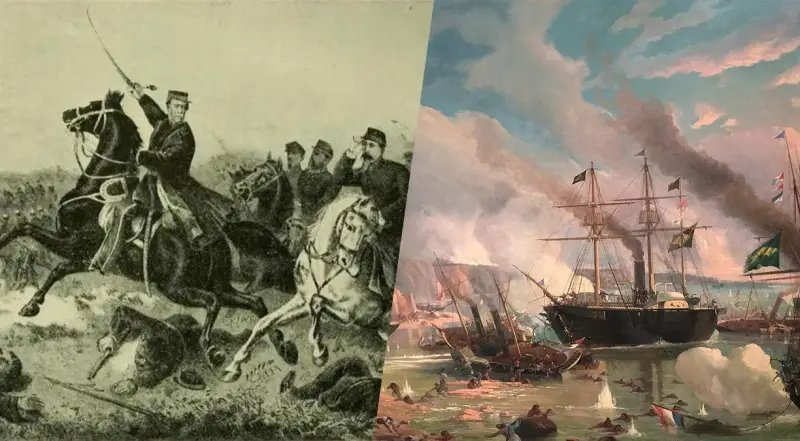
The Paraguayan War (1864–1870) began with Paraguayan dictator Francisco Solano López declaring war on first the Brazilian Empire in December 1864 and then the Argentine Republic in March 1865, followed by invasions of their territories. In May 1865, after the signing of the Triple Alliance, it turned into a war between Paraguay and Brazil, Argentina and Uruguay.
The Paraguayan War, or the War of the Triple Alliance (in Paraguay it is also called the Great War), became the longest and bloodiest interstate war in history. stories Latin America. Moreover, it became the bloodiest (apart from the Crimean War) interstate war in the world between the end of the Napoleonic Wars in 1815 and the beginning of the First World War in 1914. It lasted more than five years, ending only with the death of Solano Lopez at the hands of Brazilian soldiers on March 1, 1870, and claimed, according to various estimates, more than a million lives [1].
The leader of Paraguay, Francisco Solano Lopez, mobilized everyone who could wear weapon, including children, but this did not help him achieve victory. During the war, Paraguay lost about 40% of its territory and about 70% of its male population. However, despite the fact that the Paraguayan War is still extremely controversial among historians, every year on March 1 the country celebrates the national holiday National Heroes Day, which is established in memory of the end of this war. And some Paraguayans still consider Solano Lopez a hero, and his war an attempt to defend national interests.
But was it really so?
Was the Paraguayan War an attempt by the Paraguayans to assert their rights, or was it a suicidal struggle for territory against a superior enemy, doomed to failure and practically destroying the nation?
Paraguay under the dictatorship of Francia and C. A. Lopez
Before proceeding to describe the immediate causes of the war and the (consequences of) the course of hostilities, a few words should be said about the political history of Paraguay in the 19th century.
Paraguay, a former province of the Viceroyalty of the Rio de la Plata, which successfully seceded from both Spain and Buenos Aires in 1811–1813, was geographically isolated: until Bolivia's defeat in the Pacific War at the end of the century, it was the only one of the new independent Latin American states were landlocked. As a predominantly Guaraní-speaking nation, it was culturally isolated. Under both the dictatorship of Dr. José Gaspar Rodríguez de Francia (1813–1840) and that of his successor Carlos Antonio López (1844–1862), Paraguay also isolated itself politically and economically from its neighbors.[1]
In Soviet historiography, it was customary to positively evaluate the figure of Jose Gaspar Rodriguez de Francia. Thus, in the Soviet textbook “History of Latin America” it is noted that
Such assessments are not surprising, since the economy of Paraguay under France was based on central planning and state ownership of the means of production. That is, in fact, a Latin American dictator, a century before the Bolsheviks, successfully organized something like “socialism in a single country.” In Soviet Russia, this doctrine was formulated and adopted as a political program only in 1925 [2].
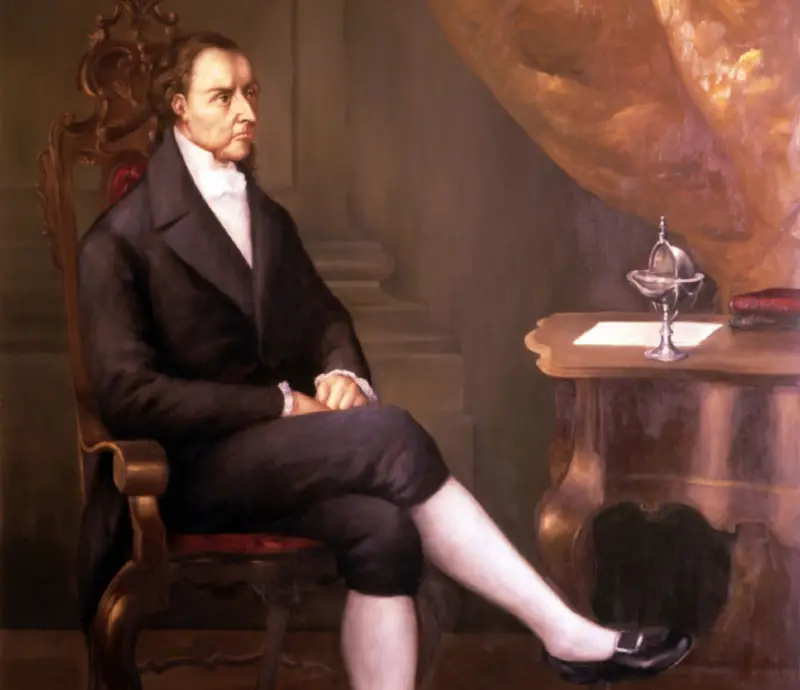
José Gaspar Rodríguez de Francia first dictator (1814–1840) of Paraguay
Francia cut off all connections with the outside world; the country found itself in complete isolation, and if foreign trade was carried out, it was only in a strictly defined place and under the control of the authorities. Paraguay lived in conditions of economic autarky, this contributed to the development of industry and agriculture, and the government constantly interfered in the business activities and social relations of the Paraguayans [4].
Large areas of land belonged to the state, about half of it was rented out in small plots and for a reasonable fee, and the rest was intended for large farms - “estancias of the homeland”, which supplied food to the city and the army. The government controlled not only production, but also the distribution of material goods.
The dictator tried to reduce the gap between the poor and the rich, provided assistance to those in need, and sought to limit the size of property and the influence of wealthy people. Free primary education was introduced in the country, and teachers not only received a salary, but were also provided with food and clothing at public expense. At the same time, fearing the emergence of opposition, Francia prevented the formation of a national intelligentsia and eliminated the system of higher and secondary education [4].
Paraguay under France had neither a constitution, nor representative bodies (since no congress was convened), nor a judicial system (the court was administered by local authorities and the dictator himself), nor even elected city cabildos, which were abolished. Management reached the highest level of centralization: Francia personally delved into everything that happened in the country [4].
Moreover, the Francia regime not only strictly regulated and controlled all spheres of the economy and public life, but also vigilantly monitored the behavior of its subjects. Control over the lives of the people was approaching absolute. Numerous secret police agents and informants searched everywhere for sedition; The system of general denunciation flourished, and the country was entangled in networks of mutual surveillance. The slightest suspicion of unreliability was enough to throw a person into prison without trial, send him to hard labor, or deprive him of his property and send him and his family to a remote remote region [2].
The movement of people within the country was also under strict control: without the sanction of the local administration, no one had the right to change their place of residence and move to another area. Entry into and exit from the country was allowed only with the personal permission of France. An attempt to leave Paraguay without permission was considered treason. Correspondence with foreign countries was subject to the strictest censorship and gradually ceased completely. Foreign books, newspapers, and magazines stopped arriving [3].
Forced labor of black slaves and prisoners was used in construction and other heavy work, as well as in agriculture. France introduced the institution of “state slavery.” During the confiscation of the property of the latifundists (large landowners - Author's note), not only lands, livestock and outbuildings were confiscated from them, but also black slaves - men and women. These people and their children did not receive freedom, but continued to be officially considered slaves, only no longer of private individuals, but of the state [2].
France's policy, according to many historians, was dictated by his worldview - the Paraguayan dictator adopted the views of the egalitarian Rousseau and tried to put his teachings into practice. On the other hand, “barracks communism” did not transform Paraguay into an economically prosperous power, but preserved its backwardness* [4].
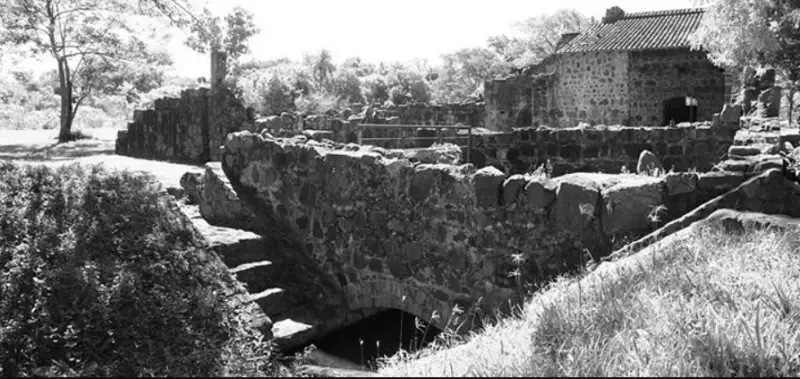
*In 1860, Paraguay's GNI (gross national income) was equivalent to 314 British pounds, Brazil - 260, Argentina - 4 and Uruguay - 392 pounds. Thus, in terms of national income, Paraguay was 226 times behind Brazil, and 1 times behind Argentina; and from Uruguay – 710 times. The photo shows the ruins of the La Rosada metallurgical plant in Ibiqui.
The dictator's successor, Carlos Antonio Lopez, largely continued the policies of France, seeking to further strengthen the role of the state in the economy. To this end, in 1843 he declared the uncultivated lands of private owners to be state property, and in 1846 he brought under his control all logging, thickets and plantations of yerba mate. As a result, most of the land fund began to belong to the state [3].
However, along with the growth of the public sector under Lopez, there was a concentration of private property. In the 40s and 50s, a numerically small but powerful group of new landowners (associated with the market), merchants and entrepreneurs appeared in the person of C. A. Lopez himself, his children, relatives and associates. Under dictatorship, they, possessing state power, had enormous opportunities for enrichment [3].
Under C. A. Lopez, almost nothing changed in the political and social life of Paraguay. Paraguay remained a closed totalitarian state, in which the constitution existed only on paper, and the dictator had virtually unlimited power [2].
One of the main differences between Lopez and Francia was that the first Paraguayan dictator was only concerned with his personal power within the country. He did not think about external expansion and did not prepare for it. Lopez had plans to expand borders and transform Paraguay into a great power. He understood that for this he needed access to the sea, and to get it, he needed to take control of the Parana River. Lopez's plan could only be realized by force of arms [2].
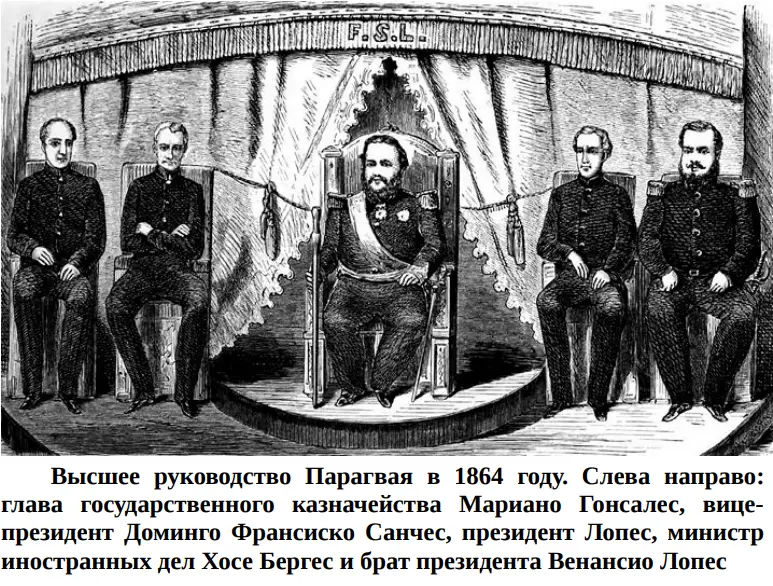
In September 1862, Carlos Antonio Lopez died before his plans were realized. However, Carlos's work was enthusiastically continued by his son, Francisco Solano Lopez, who after his father's death became president for life, and in fact, an uncrowned monarch. By the way, this “succession to the throne” clearly demonstrates how formal the republican system was in Paraguay [2].
Reasons for the outbreak of the Paraguayan War
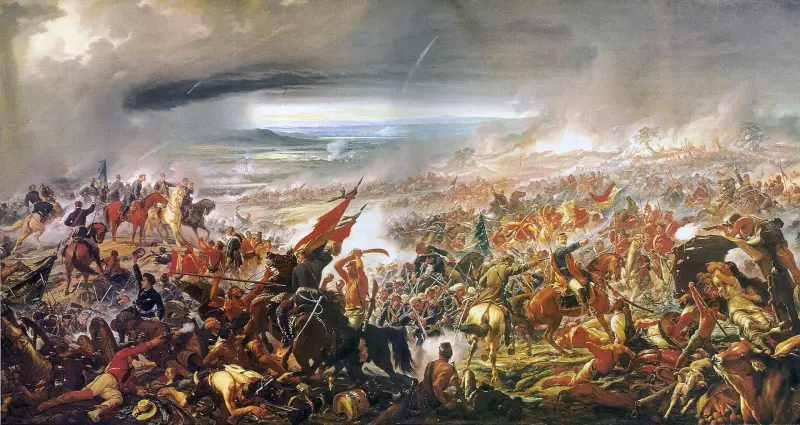
Painting by Pedro America. Battle of Avai.
As the English historian Leslie Bethell notes, in a certain sense, the Paraguayan War has its roots in the struggle between Spain and Portugal in the 17th and 18th centuries, as well as between the newly independent United Provinces of Rio de la Plata (Argentina), and first Portugal, and then by the newly independent Brazilian Empire in the second and third decades of the 19th century for control of the so-called eastern bank of the Rio de la Plata.
This conflict was largely resolved long before the events that directly led to the outbreak of the Paraguayan War. In 1828, through the mediation of Great Britain, the independent Republic of Uruguay was created as a buffer state between Argentina and Brazil. And in 1851–1852, the Argentine dictator Juan Manuel de Rosas, the main enemy of independent Uruguay, was defeated by Uruguay, Brazil and the Argentine provinces that opposed Rosas [1].
This was an episode of a long civil war between the Blancos (whites or conservatives, representing the interests of large landowners and peasants) and the Colorados (reds or liberals) in Uruguay - an uprising led by the Colorado general Caudillo Venancio Flores for the overthrow the Blancos government of President Bernardo Berro in April 1863 - which began the sequence of events leading to the Paraguayan War.[1]
The situation sharply worsened in February 1864, when the leader of the Blancos party, Atanasio Aguirre, came to power in Uruguay, torn apart by internal contradictions. His party has been fighting for control of the country with the rival Colorado Party for decades, with varying degrees of success. This struggle continually acquired an armed character, giving rise to a series of civil wars. 1864 was no exception; the Colorados did not recognize Aguirre’s victory and once again took up arms. In response, Aguirre asked for help from Paraguay, and Lopez immediately agreed, promising to assist by all means, including military. To reinforce his words, he announced mobilization in the country [2].
The Brazilian Empire received these events with alarm. The fact is that, firstly, Brazil had serious economic interests in Uruguay (Brazilians made up almost 20% of the population of this small state, and they owned about a third of agricultural land, as well as a number of industrial enterprises). And secondly, the military-political alliance between Paraguay and Uruguay seriously changed the overall balance of power in the region. Neither the Brazilians nor the Argentines were happy with this scenario.
For this reason, López's ultimatum to Brazil, in which he demanded that he refrain from invading Uruguay, which would jeopardize the security of the states of the La Plata basin, went unheeded.
After his warning was ignored and Brazilian troops invaded Uruguay on October 16, Solano López captured the Brazilian merchant ship Marquis de Olinda on November 12, heading from Asuncion to Corumba with the president of the Brazilian province of Mato Grosso on board, and on December 13 he made the fateful decision to declare war on Brazil and invaded Mato Grosso [1].
When Mitre, the President of Argentina, learned of these events, he flatly refused to allow Lopez to allow troops through the missions into the Brazilian province of Rio Grande do Sul. Argentina then declared war on Lopez and entered into a defensive-offensive alliance with Brazil and the new Uruguayan government.[5]
This is how Francisco Solano Lopez started the Paraguayan War. Were his actions rational, provoked by Brazil and Argentina and aimed at protecting national interests, or, on the contrary, were they irrationally aggressive and expansionist, and the Brazilian intervention in Uruguay only provided an excuse for a megalomaniac dictator to realize his dream of empire?
Historians do not give a clear answer to this question, but whatever the motives of his actions, Solano Lopez’s decision to declare war first on Brazil and then on Argentina and invade their territories turned out to be a serious miscalculation that had tragic consequences for the Paraguayan people [1].
War and its consequences
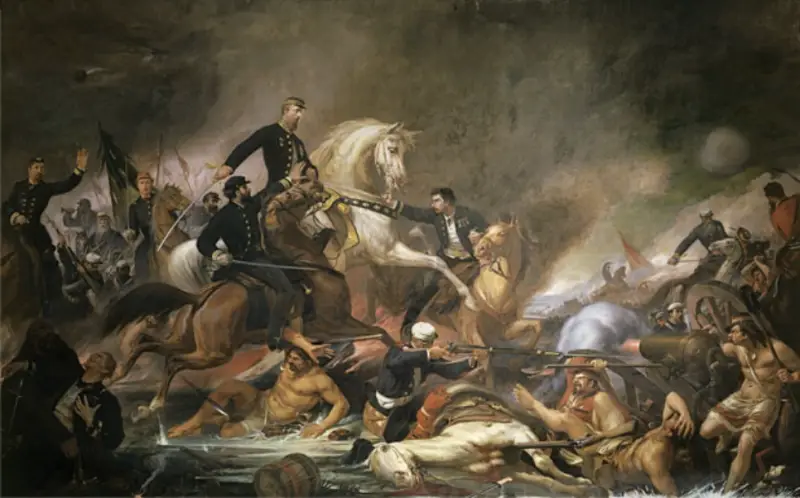
Battle of Campo Grande. Painting by artist Pedro America.
It cannot be said that Lopez’s self-confidence in declaring war on Brazil had no basis. By the beginning of the war, Paraguay, as historian Vyacheslav Kondratiev notes, thanks to preventive mobilization, had the largest army in the region, significantly exceeding even the Brazilian army in numbers [2].
The fact is that on the eve of the war, in parallel with ideological preparation (propaganda turned the majority of Paraguayans into fanatical adherents of the dictator, enthusiastically welcoming his every step and convinced that all of Paraguay’s neighbors are primitive, evil savages, jealous of the country’s prosperity), the Lopezes took measures to strengthen and modernize army. If under France the armed forces of Paraguay were rather weak, few in number and armed with outdated flintlocks, then during the reign of the Lopezes the situation changed, as the army began to be given priority.
However, given the vast differences between the parties to the conflict in size and population (and therefore in actual and potential human and material resources), the Paraguayan War was an unequal struggle from the very beginning. The population of Brazil at that time was almost 10 million people, Argentina – 1,5 million, Uruguay – about 300 thousand people, and the population of Paraguay, according to various estimates, was about 450 thousand people [1].
Militarily, Paraguay had some advantage in the first months of the war. Lopez had a well-trained army of 70–80 thousand soldiers (the standing army numbered about 57 thousand, with another 20 thousand in reserves), while the Argentine army numbered 25 thousand (of which only 10–15 thousand were available in case of emergency). war), Uruguay - 5 thousand people, and Brazil - 20 thousand people (although Brazil also had its own military police and a huge reserve of up to 200 people).
However, unlike Paraguay, which had to rely on its own arsenal and shipyards, the Triple Alliance also had access to weapons and warships purchased abroad, mainly in Europe. And the allies (more precisely, Brazil) had complete naval superiority. By the start of the war, Brazil already had the largest and most powerful navy in the region [1].
The war itself can be divided into three stages.
The first began with limited Paraguayan offensives on Mato Grosso in December 1864 and Corrientes in April 1865. In May 1865, the Paraguayan army finally crossed Misiones and invaded Rio Grande do Sul. However, the Paraguayans failed to achieve success, since the offensive was stopped by the Allied forces. The Paraguayans were never able to reach Uruguay and were forced to retreat back across the Parana River.
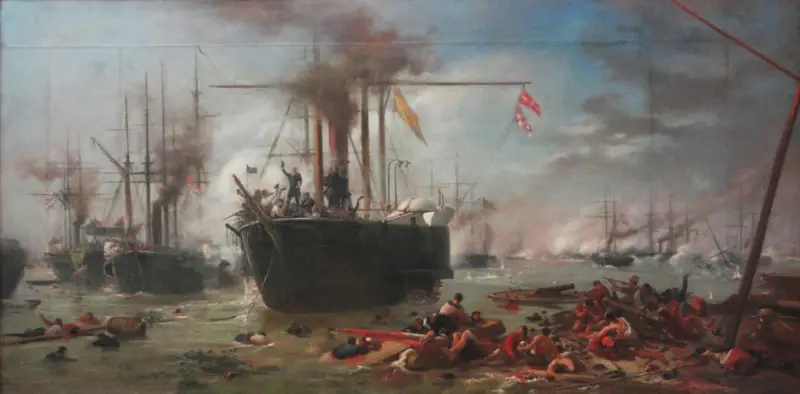
Battle of Campo Grande. Painting by artist Pedro America.
On June 11, at the Battle of Riachuelo on the Paraná River below the river port of Corrientes, in the only major naval battle of the war, the Brazilian Navy defeated the Paraguayan fleet and established an effective blockade of Paraguay, which it maintained until the end of the war.
The second and main phase of the war (which included several periods when there was little actual fighting) began when the Allies invaded Paraguay in April 1866 and established their headquarters at Tuiuti at the confluence of the Paraná and Paraguay rivers. There, on May 24, they repelled a furious Paraguayan attack and won the first major land battle of the war. However, more than three months passed before the armies of the Triple Alliance began to advance up the Paraguay River.[1]
The war soon became a war of attrition, with armies suffering far more damage from cholera than from bullets. The turning point in the fighting came in 1868, when Brazilian ironclads managed to break past the powerful fort of Humaitá. Having landed troops in the rear of the fort, the Brazilians starved out its defenders, who surrendered in August of the same year. After this success, the Allies, mainly Brazilians, moved troops into the interior of Paraguay [5]. Lopez by this time, having lost his best troops, began to conscript women and children into military service, moving on to “total war.”
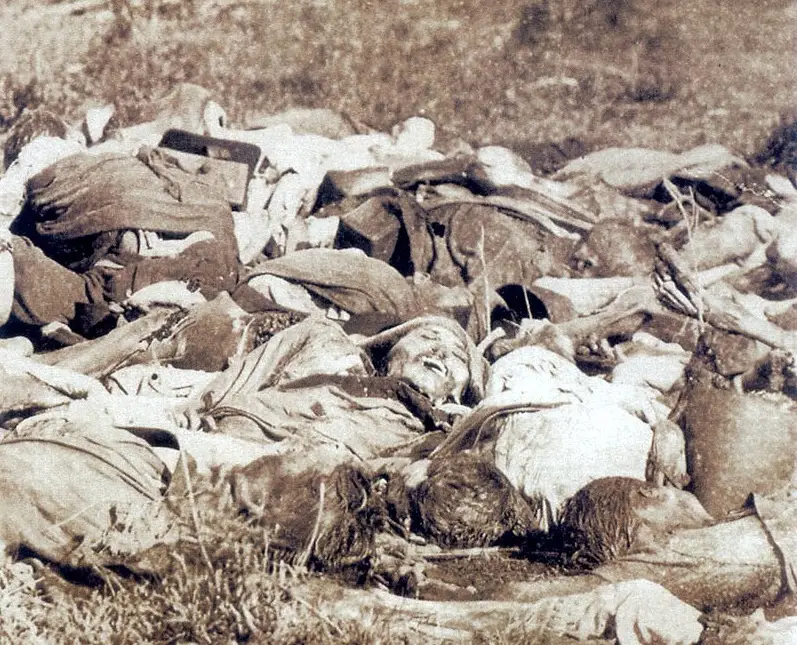
Corpses of Paraguayans after the Battle of Boqueron, July 1866. Mithras Museum, Buenos Aires
It would be another five months after the decisive defeat and virtual destruction of the Paraguayan army at the Battle of Lomas Valentinas on December 27 before Triple Alliance troops (mostly Brazilian) under the command of the Brazilian commander-in-chief Marqués de Caxias finally entered Asuncion in January 1869 and ended the war – at least that’s what they thought [1].
However, there was also a third phase of the war.
Solano Lopez formed a new army in the Cordillera east of Asuncion and began guerrilla warfare. He lost this war, and the remnants of his troops were killed in the last great battle of the war at Campo Grande or Acosta Nu, northeast of Asuncion on August 16, 1869. Brazilian troops pursued Solano Lopez for another six months before he was killed at Cerro Cora in northeastern Paraguay on March 1, 1870.[1]
It should be noted that total mobilization in Paraguay led to catastrophic consequences for the country. The acute labor shortage has hit agriculture particularly hard. Involving children in agricultural work and forced labor of prisoners of war did not solve the problem. Already in 1865, the cultivated area was reduced by a third, the number of livestock also dropped significantly, and food production decreased accordingly [2].
By the beginning of 1867, almost the entire male population of the country was put under arms. Only women, children, old people and disabled people remained in the villages. Food production was going downhill, and its shortage was felt not only in the rear, but also at the front. Things were even worse with the uniforms. Before the war, Paraguay was completely self-sufficient in textiles, but the reduction in farmland affected primarily cotton crops, since in a warm climate you can at least live without clothes, but you cannot live without food [2].
After the loss of Asuncion, when it was already obvious that the war was lost, Solano Lopez announced the mobilization of everyone capable of holding weapons. It looked crazy, but not only 14-16 year old teenagers, but also boys from 10 to 13 years old, as well as old people and disabled people who had previously been dismissed from the army due to age or after severe injuries, joined the ranks. In fact, Lopez's last army consisted of emaciated, hungry children and gray-haired elders. Their uniform often consisted only of a worn leather cap and loincloth, and their weapons consisted of a machete and a pike with an iron tip [2].
Francisco Solano Lopez's willingness to fight to the last Paraguayan is amazing, since the desire for war at any cost at the final stage of the war openly resembled genocide of his own people.
As a conclusion
The war against the Triple Alliance ended in a severe defeat for Paraguay. The destroyed economy, the loss of a significant part of the territory, all this became the price paid for the adventurous policy.
The lack of accurate pre-war statistics makes it difficult to reliably estimate losses. Following the consensus estimate, at the beginning of the war the population of Paraguay did not exceed 450 thousand people. The first post-war data, obtained from the 1873 census, indicated that the population of Paraguay was 221 thousand people [6]. Based on these numbers, we can say that the total losses of the Paraguayan population were catastrophic.
Since the Middle Ages, no state in the world has experienced such a crushing demographic blow. As is usually the case, the war was especially brutal on the male part of the population. According to the 1873 census, there were 106 women, 254 children and only 86 adult men in Paraguay at that time. Thus, almost four times more women survived than men, and in absolute numbers the imbalance between them was 079 thousand people [28].
A significant share of the blame for the catastrophic mortality rate of 1868–1870 lies with the leadership of Paraguay and personally with Francisco Solano Lopez, on whose orders the Paraguayan army confiscated or destroyed food during its retreat, thereby dooming the inhabitants of the abandoned areas to extinction [2].
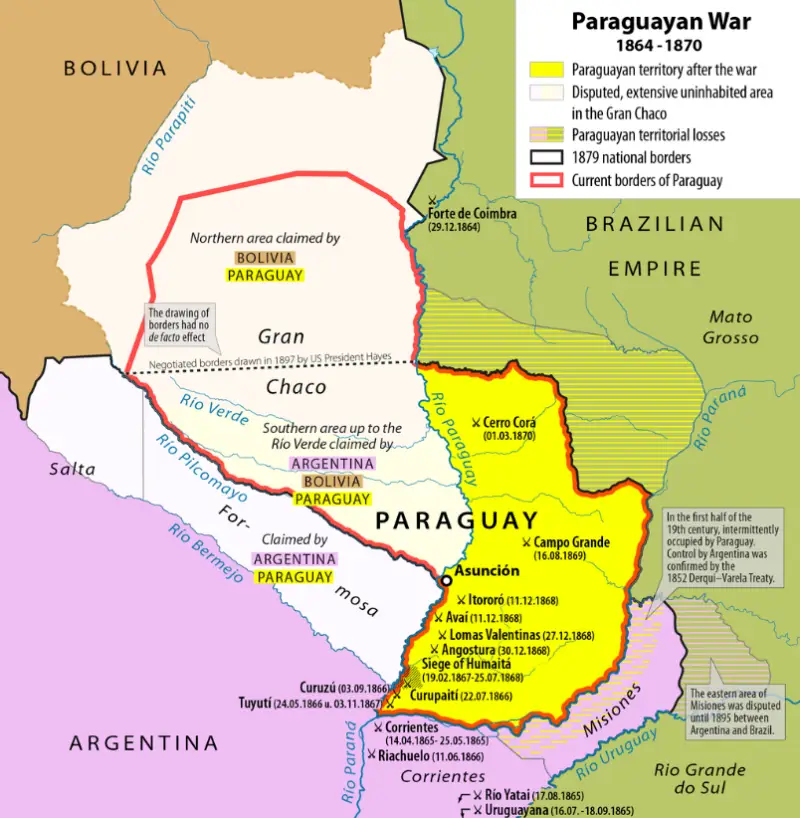
Paraguay ultimately survived as an independent state, not least because of the rivalry between the victors, but its territory was reduced by 40%, its economy lay in ruins and its infrastructure was destroyed.
This was the end of dictator Francisco Solano Lopez's challenge to his political opponents, his attempt to turn Paraguay into an empire and achieve greatness.
Was this attempt worth such sacrifices?
Historian Vyacheslav Kondratyev, for example, gives a negative answer to this question:
Использованная литература:
[1]. Leslie Bethell. The Paraguayan War (1864–1870). London: Inst. of Latin American Studies, 1996.
[2]. Kondratyev V.I. The Great Paraguayan War. – M.: Fifth Rome, 2018.
[3]. Alperovich M. S., Slezkin L. Yu. History of Latin America (from ancient times to the beginning of the 2th century): Textbook for universities. – 1991nd ed., revised. and additional – M.: Higher. school, XNUMX.
[4]. Proskonina O.I. History of Latin America (until the 2009th century) - M.: Publishing house “Ves mir”, XNUMX.
[5]. Thomas A. B. History of Latin America. M. Foreign Literature Publishing House, 1960.
[6]. N. Yu. Kudeyarova. Paraguay's war against the Triple Alliance: historical memory and the search for the foundations of identity. Latin America, No. 1 (568), January 2022.
Information